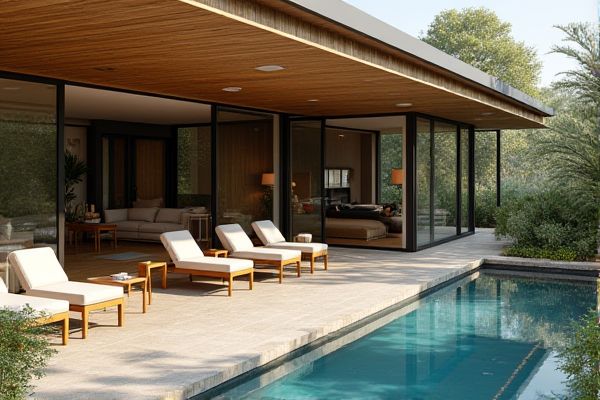
A covered terrace provides shelter from weather elements, allowing you to enjoy outdoor space regardless of sun or rain, while an open terrace offers unobstructed views and direct sunlight for a more natural experience. Discover which terrace type best suits your lifestyle by exploring the full comparison in the article.
Table of Comparison
| Feature | Covered Terrace | Open Terrace |
|---|---|---|
| Weather Protection | Provides shelter from rain, sun, and wind | Exposed to all weather elements |
| Usage | Usable year-round with added comfort | Best for fair weather and seasonal use |
| Privacy | Offers more privacy with walls or screens | Limited privacy due to openness |
| Maintenance | Lower maintenance; protected furniture | Higher maintenance due to exposure |
| Cost | Higher initial cost for construction and materials | Lower initial cost; simpler design |
| Lighting | Requires artificial lighting options | Natural lighting throughout the day |
| Design Flexibility | Limited by roof structure | More flexible design options |
Introduction to Covered Terrace vs Open Terrace
A covered terrace provides shelter from weather elements such as rain and excessive sunlight, making it suitable for year-round use and enhancing outdoor comfort. In contrast, an open terrace offers unobstructed views and maximum exposure to natural light, ideal for activities that benefit from direct sunlight and fresh air. The choice between covered and open terraces depends on climate, intended use, and personal lifestyle preferences.
Key Differences Between Covered and Open Terraces
Covered terraces provide shelter from weather elements such as rain and sun, allowing you to enjoy the outdoor space year-round, while open terraces offer unobstructed views and direct sunlight exposure ideal for sunbathing and gardening. The structural design of covered terraces often includes roofing materials like pergolas, awnings, or solid roofs, enhancing privacy and temperature control compared to open terraces that feature an exposed environment. Maintenance requirements differ as well, with covered terraces needing care for roofing materials and open terraces requiring regular cleaning from debris and weather impact.
Climate and Weather Considerations
Covered terraces offer superior protection against harsh weather conditions such as heavy rain, intense sun, and strong winds, making them ideal for regions with variable or extreme climates. Open terraces provide better ventilation and natural sunlight but may limit usability during inclement weather or intense heat. Selecting between a covered or open terrace depends on local climate patterns, balancing shade and shelter needs for maximum comfort.
Privacy and Security Aspects
A covered terrace provides enhanced privacy by blocking sightlines from above and neighboring buildings, while an open terrace often exposes your space to external views. Security is improved on covered terraces since the structure limits access points and offers protection against intruders or weather-related damage. Choosing a covered terrace ensures better control over your outdoor environment, balancing comfort with safety and discretion.
Maintenance and Durability Factors
Covered terraces offer enhanced protection from weather elements, reducing maintenance needs and extending durability by preventing damage from sun, rain, and wind. Open terraces require more frequent upkeep, such as sealing and cleaning, to combat exposure-related wear and tear, including fading, cracking, and water damage. Choosing a covered terrace can save you time and costs associated with repairs and upkeep, ensuring long-term resilience.
Aesthetic Appeal and Design Flexibility
Covered terraces offer enhanced aesthetic appeal by allowing for integrated lighting, ceiling treatments, and weather-resistant materials that create a cohesive outdoor living space. Open terraces provide greater design flexibility, enabling you to customize layouts with movable furniture, garden elements, and open views that adapt to changing seasons. Your choice depends on prioritizing a sheltered, polished look or an adaptable, airy environment.
Functional Use and Versatility
Covered terraces offer enhanced functional use by providing shelter from sun and rain, allowing you to enjoy outdoor space year-round regardless of weather conditions. Open terraces excel in versatility for activities that benefit from direct sunlight and unobstructed views, such as sunbathing or stargazing. Choosing between a covered or open terrace depends on your preference for protection versus exposure, impacting how you utilize and adapt your outdoor living area.
Cost Implications: Covered vs Open Terrace
Covered terraces typically involve higher initial costs due to materials like roofing, beams, and weatherproofing treatments, but they offer long-term savings by protecting furniture and reducing maintenance. Open terraces generally have lower upfront expenses, relying on simpler flooring and minimal structural work, though they may incur higher costs over time from weather damage and seasonal upkeep. Your choice between covered and open terraces should consider both immediate budget constraints and ongoing maintenance investments.
Energy Efficiency and Comfort
A covered terrace enhances energy efficiency by providing shade, reducing indoor cooling costs during hot months, and protecting outdoor furniture from weather damage. Open terraces often expose spaces to direct sunlight and wind, which can increase temperature fluctuations and decrease overall comfort. Incorporating a covered terrace improves thermal regulation and creates a more comfortable, usable outdoor area year-round.
Choosing the Right Terrace for Your Home
Choosing between a covered terrace and an open terrace depends on your climate, lifestyle, and intended use. A covered terrace offers protection from sun and rain, extending usability year-round and enhancing outdoor comfort, while an open terrace provides unobstructed views and natural ventilation, ideal for enjoying sunny weather. Consider factors like maintenance, privacy, and shading preferences to select the terrace type that maximizes your outdoor living space.
 homyna.com
homyna.com